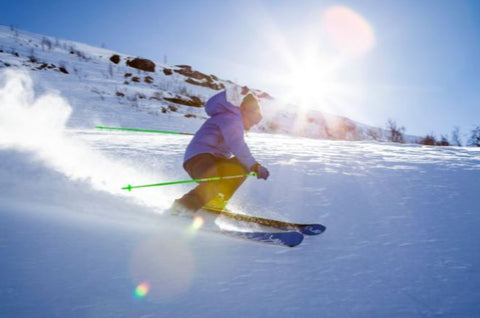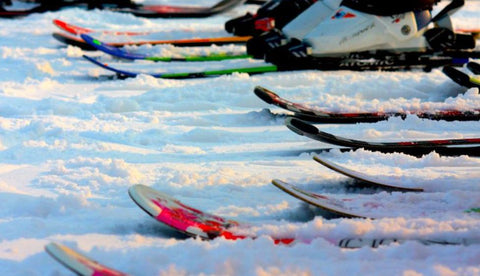Skiing can be described as a popular sports discipline and exciting entertainment.
It attracts attention and sparks the interest of many people around the world.
For many years, this recreational activity has had an important place in the culture of many people.
It is considered an engaging and healthy activity through which many people have learned to conquer mountain ranges, move through snowfields and perform other activities in extreme conditions.
Evolution of Skiing: Brief Overview and Types
The equipment that led to the appearance of the first skis appeared a long time ago. Back then, snowshoes were designed to make walking across snow-covered fields and slopes easier. Their appearance changed considerably when man learned to see trees into boards. Since that time, the look of skis has changed a great deal. To learn about skiing equipment, visit this web source: https://www.britannica.com/sports/skiing/Skiing-equipment.
Skiing began to be seen as a mode of transportation and a variation of the sport. The Norwegians were the first to do so in 1733. At that time, Jens Emmahusen published the first manual, which dealt with training in skiing with a sporty emphasis. In 1768 the first competitions were held in all kinds of skiing. Today, there are six types of this discipline. You can read more details about each of them below.
|
Ski racing |
It is a cyclic sport, which is a race at different distances. There is a variety of a type of ski race. The options include a marathon, split start, mass start, pursuit, and others. Relays and individual sprints are especially popular among fans of this discipline. |
|
Alpine Skiing |
It is a downhill race, which takes place on a predetermined route. The duration of the track itself and the height of the jumps are always set in advance. Today there are several subtypes of alpine skiing. They include slalom, downhill, and others. |
|
Ski Jumping |
The essence of this sport is to make a jump on skis from a springboard to the maximum distance. For this purpose, special ski suits are used, which help the athlete to get off the ground and regulate the flight. |
|
Snowboarding |
This sport uses a special board that helps the athlete descend the mountain along a snow-covered track. There are the following types of snowboarding competitions: boardcross, half-pipe, jibbing, bigair, and parallel giant slalom. |
|
Nordic Combined |
This discipline requires the athlete to cover a distance of 15 km, as well as to make two jumps from the ski jump ( there are two attempts for that). |
|
Freestyle |
This is the most dangerous type of skiing, which involves performing various tricks and jumps. It includes mogul, ski cross, slopestyle, and others. |
As we can see, there are many different variations of skiing today. All of them are dangerous because even the slightest mistake can have serious consequences. If you are not ready to risk your life but still want to feel the rush of extreme sensations, pay attention to gambling. In particular, playing free video slots, no download, and no registration is recommended. This is possible thanks to the unique demo modes of various games. The developers expressly release them to ensure that all users can enjoy their time at the slots without spending any personal money.

You must find a reliable online platform to play free game slots casino.
The main criterion for selection is the presence of a special license.
The platform can be trusted if it has official permission to operate.
In this case, the player will have access to free slots no download, and other games for real money.
They include poker, roulette, blackjack, bingo, and many others.
Impact of Skiing on Human Health
Skiing has many advantages. First and foremost, it has a positive effect on human health. An athlete who regularly trains on skis becomes more enduring and stronger. In addition, it is worth highlighting the following points:
- frequent exposure to sub-zero temperatures strengthens the human immune system;
- since skiing is a cardio exercise, it supports the heart and blood vessels;
- this discipline helps to reduce stress levels and generally improves a person's well-being;
- skiing helps to cope with insomnia and stabilize the nervous system.

Professional athletes say regular exercise helps you lose weight, build muscle mass, and maintain shape.
However, they note that this recreational activity is only suitable for some.
In some cases, skiing can cause many health problems. That's why contraindications to this sport include:
- abnormalities of the musculoskeletal system or the spine;
- severe disorders of the heart, blood vessels, or respiratory system;
- pregnancy;
- problems with joints;
- weakened immune system.
It is important to note that even if a person has no problems with the heart or immune system, details of which can be found here: https://en.wikipedia.org/wiki/Immune_system, it is worth reducing participation in skiing after a recent illness.
What Does Skiing Feel Like?
Before getting into skiing, many people wonder if this sport will bring the sensations they want to experience. It is easy to get an answer to this question if one understands how the process of skiing happens. First of all, a person experiences adrenaline and the sensation of speed. Thanks to the above, many people start skiing, as, during the descent down the slope, you can experience incredible lightness and freedom. However, it is worth noting that skiing is also associated with feelings of wind and cold on the face and body.





